| |
During the mid 1950’s, the US Army
activated the "gyroscope" program which saw complete CONUS based units
rotate to Germany for usually a three year period and then return
stateside. The Blackhorse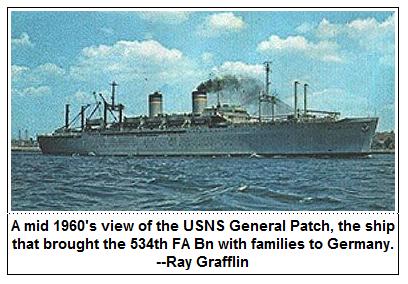 Regiment saw its first tour on the border
through this plan, serving in southern Germany near the Czech border
from 1957 until 1964. Regiment saw its first tour on the border
through this plan, serving in southern Germany near the Czech border
from 1957 until 1964.
At Daley Barracks in 1956, the 2/14
ACR went about the normal routine of border surveillance and standard
training cycles while the personnel of the other major unit on post,
the 290th Field Artillery battalion, were alerted that they would
rotate stateside. As told by Mr. Ray Grafflin and Mr. Glenn McGinnis,
both of Apha Battery, here is the story of the gyroscope deployment of
his unit to Bad Kissingen.
534th Field Artillery
Battalion: A Lucky Unit
Ray Grafflin: During the mid 1950s , the
Department of the Army launched a new concept,
"Operation Gyroscope".
The reasoning was to improve morale of married Officers and Non Coms,
instill greater Esprit de Corps, generate higher reenlistments and
exercise the deployment mechanisms. Under the Gyroscope concept
anything from a Battalion, on up to a Division, would be posted abroad
as a complete entity, less its major equipment, and be returned to its
original location. Several units, notably the 3rd Armored and the 4th
Infantry Divisions, and less noticeably, the 534th Armored Field
Artillery Battalion, 155MM (Self Propelled) were sent to Germany
through this program.
The project was deemed to be
"somewhat successful", but was terminated during 1958–59.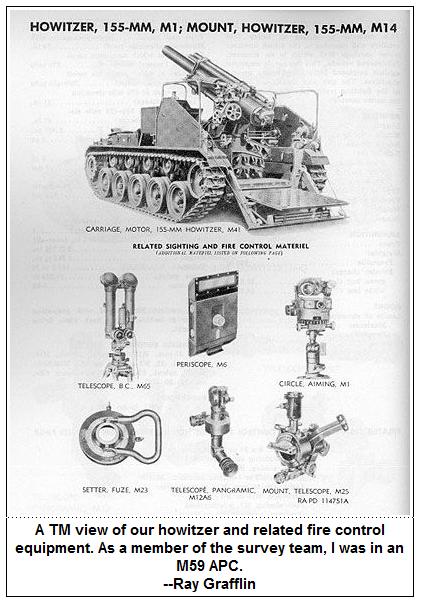
My story is about how the 534th arrived at Daley, as a part of the
Border Defense Force (whatever that really meant!) and found itself as
a neighbor of the 2/14th Armored Cavalry, and then midway through it’s
tour was reflagged as the 1st Battalion, 92d Artillery Regiment.
For 32 Officers, 3 Warrant Officers, 97 NCO’s and 490 EM scattered
about parts of CONUS, but mostly at Fort Sill, life started to change
upon the publication of Movement Orders Number 35 (Gyroscope) dated 22
October 1956. This order gave the first official Heads Up! to the
290th FA Bn in Bad Kissingen that they were being rotated back to Fort
Sill and replaced by the 534th. At this point, the 534th consisted of
a very tiny cadre tasked with processing all the rest into the unit,
and also to prepare enormous quantities of paperwork in support of
artillery training at Sill.. During the next few months, culminating
on 6 Feb 57, the unit went through a hectic period of intensive
training and ‘bonding’. I re - trained from an administrative MOS to
an Artillery Survey Specialist. (I never managed better than a ’C’ in
High School!) It was with an enormous sense of relief we boarded a
train with troops, Officers and NCOs plus our accompanied dependents
and took off through Canada to Brooklyn Army Terminal, embarking onto
the USNS General Patch. Seven days brought us to Bremerhaven and onto
yet another train to Bad Kissingen, arriving on station on the 15th of
February. The 534th was once again a combat unit with a real mission,
exactly what we needed.
Glenn McGinnis: I joined the unit
right out of mechanic school at Fort Sill, I guess this was as they
were rebuilding the battalion to go to Germany. I recall the train and
ship rides, big adventures for a nineteen year old from south Texas!
Ray: Arrival at Bad Kissingen was quite an event; the rear party of
the 290th and our advance party had transferred ownership of the TO &
E and ordnance prior to our arrival. My memories of the first ten days
are a mix of rushing to get up to speed on a lot of unfamiliar
equipment, learning geography and topography – keeping a couple of
young 2 LTs (straight out of ROTC and OCS respectively) happy and out
from underfoot (thankfully with the connivance of the Bn CO) and
assuring my wife that she had some time coming to help her as well!
Even now I recall with heartfelt thanks SFC Jim Bosworth and his wife
Mary from the 2/14th who were on the ground floor of our apartment
house at 6 Pfalzstrasse whose generous and unstinting help to my wife
and myself will never be forgotten. I know that my colleagues also
received the same treatment from other members of the 2/14th.
Glenn: I was a mechanic and we were
trained to work on all the vehicles in the battalion. Once we got to
Daley Barracks, all I saw for the first three weeks were the motor
shop, my room and the mess hall. LTC Braxton, the Bn Commander and CPT
Powell, the Btry Commander, thought the " hand off " equipment was in
pretty sorry shape. So, we worked six days a week until it was
acceptable.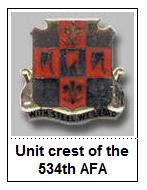
Ray: Our lives were very ordered,
seldom was there any deviation from standing orders. This could
certainly be a blessing in that planning for your family 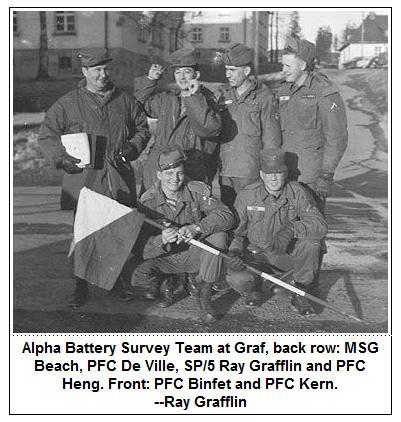 and private
life was fairly easy – but there were some days truly out of the
ordinary. Among unusual happenings: one of our observation aircraft
crashed during one exercise and a full scale search and rescue effort
began. We found the pilot unharmed but the plane was a total write -
off. On another occasion, two of our gate guards were fooling around
with their 45 caliber pistols when a shot fired and one man was
wounded in the stomach. He was evacuated, patched up and eventually
returned to duty; it was a very close call. The most striking memory
of that sort of incident occurred at Grafenwoehr. The entire battalion
was pulled on to one, huge firing point and we were observing the
action from an adjacent hill. An armor unit was on a near by range
when suddenly we heard a tank gun fire and watched as the training
round went skipping through the battalion position. As everyone ran,
the round ricocheted and finally bounced through the camouflage
netting of one of the howitzers. When we reached the gun, we found the
fuse setter frozen to his spot, projo in the cradle and fuse wrench in
hand. The tank round had buried itself within two feet of his
position. Like I said, I think we were a lucky unit. and private
life was fairly easy – but there were some days truly out of the
ordinary. Among unusual happenings: one of our observation aircraft
crashed during one exercise and a full scale search and rescue effort
began. We found the pilot unharmed but the plane was a total write -
off. On another occasion, two of our gate guards were fooling around
with their 45 caliber pistols when a shot fired and one man was
wounded in the stomach. He was evacuated, patched up and eventually
returned to duty; it was a very close call. The most striking memory
of that sort of incident occurred at Grafenwoehr. The entire battalion
was pulled on to one, huge firing point and we were observing the
action from an adjacent hill. An armor unit was on a near by range
when suddenly we heard a tank gun fire and watched as the training
round went skipping through the battalion position. As everyone ran,
the round ricocheted and finally bounced through the camouflage
netting of one of the howitzers. When we reached the gun, we found the
fuse setter frozen to his spot, projo in the cradle and fuse wrench in
hand. The tank round had buried itself within two feet of his
position. Like I said, I think we were a lucky unit.
Glenn: I remember the pilot story, it
was the middle of Winter and it took a few days to find the guy in the
woods. He survived by wrapping himself in his parachute. I also
clearly recall the incident at Grafenwoehr. I think that round bounced
through a couple of sets of Camo netting on the gun line before it
finally stopped. Everyone agreed that it was a very close call.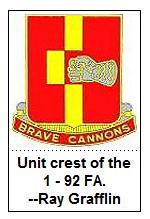
Ray: On a day to day military basis,
there was little contact between the two units sharing Daley Barracks.
We were either out in the field practicing or in barracks performing
all echelons of maintenance. We had no actual role up on the border,
rather we were tasked to provide support fire for the 14th front-line
units. I know that all of the unit surveyors spent a lot of time on
independent surveys up and down the border area (about 3 – 5
kilometers back) adjusting the firing lists and survey coordinates in
case the East decided to come romping across. That was fairly good
duty, we booked into either a Gasthaus or a Pensione every night and
had a good dinner, and a few liters of Pilsener too! I like to think
that all that would have made a difference if the flag had gone up,
but I imagine that the reality would have been more like a short,
noisy interlude. I am glad we never had to find out.
Like all peacetime soldiers, the troops trained incessantly, and
mostly boringly, but played very hard and enthusiastically! Unusually,
few serious incidents seem to have marred our tours. Certainly there
were no murders, rapes, assaults or burglaries during our time there.
Many of the troops involved themselves in GYA and local sports
activities and undoubtedly kept the local bars, clubs and restaurants
busy and profitable! I fondly remember the Franziskaner in town – a
most magnificent Weiner Schnitzel, homefries and salat were to be had
there. From a window in our apartment we could see the valley where
the Saale River was. I remember the glider being launched from there
and soaring up and around for hours. Always meant to have a go, but
never got around to it.
Glen: Yes, I recall the Germans as
friendly, I was only a junior enlisted man so there wasn’t much money
for going down town but on p ost we had movies, the EM Club and the USO
Center. Also, remember that our duty week ran to a half day on
Saturday. This was for inspections of the barracks, equipment, motor
shop and so on. Any faults noted were then corrected on Saturday
afternoon so, we all had an interest in " looking good " for the
inspections. You needed to get a " pass " to leave Daley, the CQ was
authorized to give them out but bed check was at 24 00 hrs so you
couldn’t wander too far. I recall the barracks as OK, the heat worked
but there were problems with enough hot water for the showers. Some
guys showered late at night and others would wait until the next
morning. That worked. ost we had movies, the EM Club and the USO
Center. Also, remember that our duty week ran to a half day on
Saturday. This was for inspections of the barracks, equipment, motor
shop and so on. Any faults noted were then corrected on Saturday
afternoon so, we all had an interest in " looking good " for the
inspections. You needed to get a " pass " to leave Daley, the CQ was
authorized to give them out but bed check was at 24 00 hrs so you
couldn’t wander too far. I recall the barracks as OK, the heat worked
but there were problems with enough hot water for the showers. Some
guys showered late at night and others would wait until the next
morning. That worked.
Ray: The 534th finally came to an end officially on the 14th of July
1958 and in a ceremony on the parade ground, was re - flagged as the
1st Battalion, 92d Artillery. The officers of the battalion had an
official photograph to mark the occasion, it is odd to see the " old
style " uniforms in the photo. I’ll try and get a clear scan produced.
During this period, my brother in law, a tanker in the British Army
visited and we made a big effort to show him a good time. My friends
in the 2/14 ACR showed him their equipment and we shared may laughs
and more than a few beers. 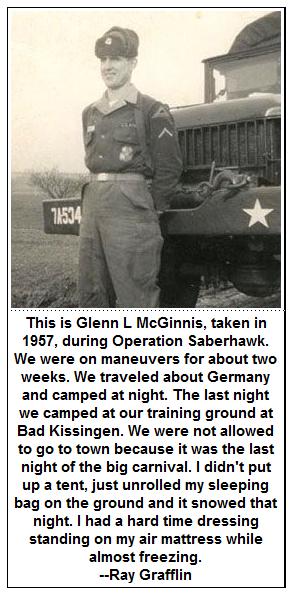
I remember being in the NCO Club one
winter evening and an off duty MP came in for a drink. He started
telling us about a report that had come in while he had been on duty,
that some naked guy was running around the town. They had sent a
patrol out to check out the report but without success. The next
morning I went in, checked with the CQ to be sure all was well over
night. We were stood there chatting when an NCO walked in and said
that when he woke up, he couldn’t find his uniform, and could he
report it as stolen! We hushed him up, and retraced his steps finally
arriving at Charlie‘s Gasthaus, and in the gents room urinal, lo and
behold, a uniform! Never did find out what had led to his nude romp!
One of our gun crew chiefs was going with our Firing Battery Officers’
maid, and finally decided to marry the girl. She was a local girl, and
wanted to do it in style, so she asked to be married in the big church
in the town square. In the meantime, he asked me to be the Best Man,
so we pulled out all the stops and went for a uniform wedding with all
the extras. His gun crew decorated the gun carriage with flowers and
ribbon and mounted two silver chairs on the front deck. This being an
old artillery custom to parade the bride and groom around on a gun
caisson. We also had the lads wrap rammer staffs in silver foil, and
we made an arch of rammers for the happy couple. The photo shows us
all coming out after the service. All went pretty well after the
service, but a memorable event was made even more memorable before the
ceremony when the gun carriage managed to run over and mash flat a VW
beetle on the way to the church! Fortunately, someone at Corps had a
sense of humor and signed off on a reparations order, so at least we
didn’t have to shell out of our pockets. Once again, our luck held.
It was shortly after this that our
draftee troops completed their two years and rotated home. We received
a new draft of around 400 young troops, and the next few months were
pretty hectic with training, orientation and generally getting our
people squared away for duty in Bad Kissingen. What did help a lot was
the higher than average number of reenlistments we experienced.
Several of my team re-upped, so it did help to keep a family
atmosphere. In truth though, the Battalion never really seemed quite
the same again.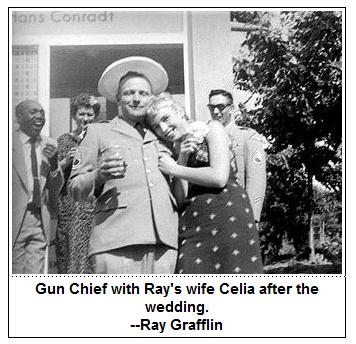
Glenn: I really don’t recall that
period very well but in my last year there, I was the Records Clerk
for the Motor Pool and I enjoyed the attention to detail kind of work.
I left the unit prior to the official return to the USA and left the
Army at the end of my enlistment. It was all a big adventure for me
and I got to take leave and see the World’s Fair at Brussels as well
as Amsterdam and Copenhagen. I remember those days fondly.
Ray: We were in Europe to support the Armored Cavalry, and I guess we
served that purpose to the best of our ability. We finally folded our
tents and stole away from Germany on the 17th of October 1959 aboard a
sister ship to the General Patch, arriving in New York on the 26th of
October, this was the end of our German adventure.
As a post script to the story, the 1-92nd went on to Fort Bragg, and
then served with distinction in Vietnam and in Desert Storm. The
battalion and batteries received valor awards and a number of solders
were highly decorated. Yes, there were casualties and Vietnam was a
tough period for all involved but on the whole, we were a lucky unit.
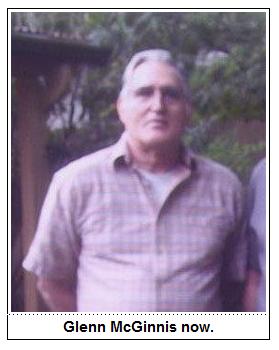 |
|